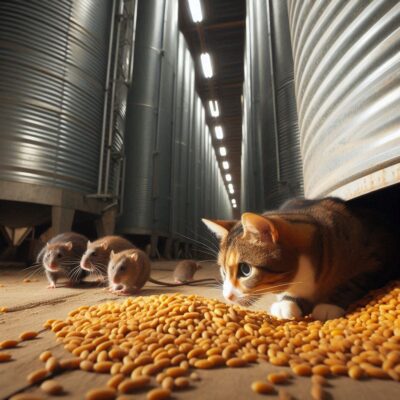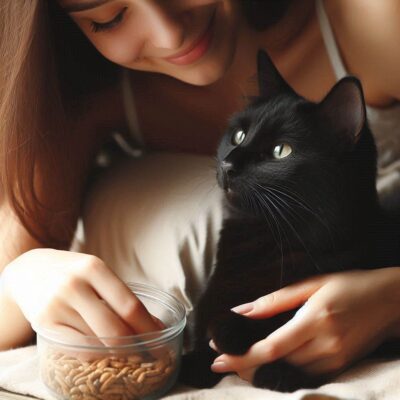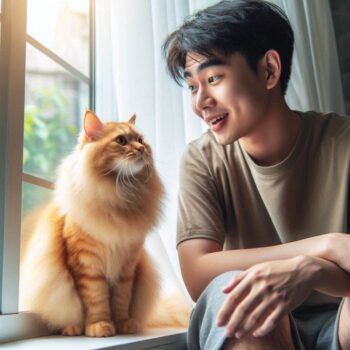A recent Wall Street Journal article discusses two new books on the cat and human connection. These books delve into the enigmatic relationship between us and our furry feline friends. How and why did this connection evolve? How does science explain this phenomenon?

Beginning in ancient times, this relationship became a naturally occurring process. It wasn’t planned; it evolved from the interactions between cats and humans. Cats first offered a valuable service, by destroying vermin who ate human food supplies. Then, as we got better acquainted, we developed appreciation for other features of the relationship. Their hunting skills gained admiration, but their mere presence as part of our daily life and their affectionate and playful nature also resonated with us.
The cat-human relationship evolved to become more of companionship, with both parties benefiting from the bond. Besides their great value in protecting food supplies, they provided emotional support and good company in exchange for our providing food, shelter, and medical care.
Some Scientific Findings
The science behind this bonding grows from the exchange of pheromones and the increase of oxytocin levels. Cats use pheromones for communication with each other and with humans. They pass along pheromones through scent glands on faces, paws, and tails. It is believed that we, too, release pheromones, perhaps from the skin, helping with this communication.
When cat and human interact, both experience increased oxytocin levels. This hormone has great importance in social bonding. During childbirth and breastfeeding in humans, oxytocin is released and contributes to maternal bonding. The human-cat bond may be similar to the bond between mother and child.

Delving into the Human-Feline Bond: Insights and Revelations
In Sarah Brown’s book, “The Hidden Language of Cats: How They Have Us at Meow”, she reminds us that the meow is “almost exclusively reserved for cat-human interactions.” Its fundamental frequency (609 hertz average) is pitched at about the same level as the cry of a human baby. Brown points out that the sound has “remarkably similar” acoustics. Thus, cats may have hotwired our brains so we must respond to an urgent need to care for them, as if they were a baby.
Cat Body Language
To strengthen the bond with our feline, it behooves us to pay attention to the cat’s body language. Learn what the cat says with tail, ears, body position, and eyes. Each of these parts of the cat’s body can tell us something about the feelings the cat might have.
In “The Cat’s Meow: How Cats Evolved From the Savanna to Your Sofa,” by Jonathan B. Losos, he discusses, for example, the importance of the cat’s tail position. He tells us that if the tail is up, it means “I come in peace” or “glad to see you.”

He says that the only species to use this signal are the domestic cat and the lion. Mr. Losos connects this trait with the fact that lions and house cats live in social groups. Thus, the cat becomes part of our social group and gains a sense of security and comfort from his association with us. In return, as you pet your cat, you reduce your stress and anxiety. Both cat and human gain a positive benefit from their bond.
Cat Companionship Has Therapeutic Value
Particularly compelling is the therapeutic effects of cat companionship. The purr of the cat is not just soothing but can actually help with healing. The feline presence has been shown to reduce stress and anxiety, and to have a positive impact on human health.
Creating A Strong Bond
How do cats choose their humans? What helps create a strong bond between us and our feline companion? First of all, a personality compatibility becomes very helpful. A laid-back cat might fit well with a relaxed person, while a more active cat could fit better with a more energetic human.
A compatible lifestyle has importance. If the cat requires a lot of attention, it might not be a good fit if the human works long hours. The person on such a schedule needs a more independent cat.

Getting a kitten used to interacting with humans at an early age will help prepare the small creature for spending time with people as the cat grows up. Socialization, or exposure to this new species called a person can make a good bond more likely.
It All Started A Long Time Ago
These two books discuss how civilizations from Egypt to the present day have become enchanted by these graceful creatures. They point out the therapeutic effects of cat companionship, and how the cat seems to have an innate ability to understand and to respond to our emotional needs.
The research findings presented in these texts about the emotional intelligence of cats are striking. It turns out, cats are quite adept at reading human gestures and can adapt their behavior in response. This emotional acumen elevates our furry companions from mere household pets to full-fledged family members.
Beyond the Purr: Practical Takeaways for Feline Aficionados
These featured books from the Wall Street Journal offer actionable steps to create a deeper bond with your cat. From the way you pet them to recognizing when they’re stressed, the books provide a roadmap to a happier, healthier cat.

For current or prospective cat owners, know that these publications are more than just a good read—they’re a resource. They prompt us to consider not just our needs, but the needs and natural behaviors of our feline friends. Cats, like us, have a whole range of emotions and ways to communicate them.
As a responsible cat owner. it is important to engage with your cat regularly, observe their habits, and respect their boundaries. These are the hallmarks of not just a cat owner, but a cat companion as well.
References I used for this post: https://blog.catbandit.com/why-cats-bond-with-humans-exploring-the-fascinating-connection/ https://www.wsj.com/arts-culture/books/two-books-on-the-feline-human-connection-427aa14a

